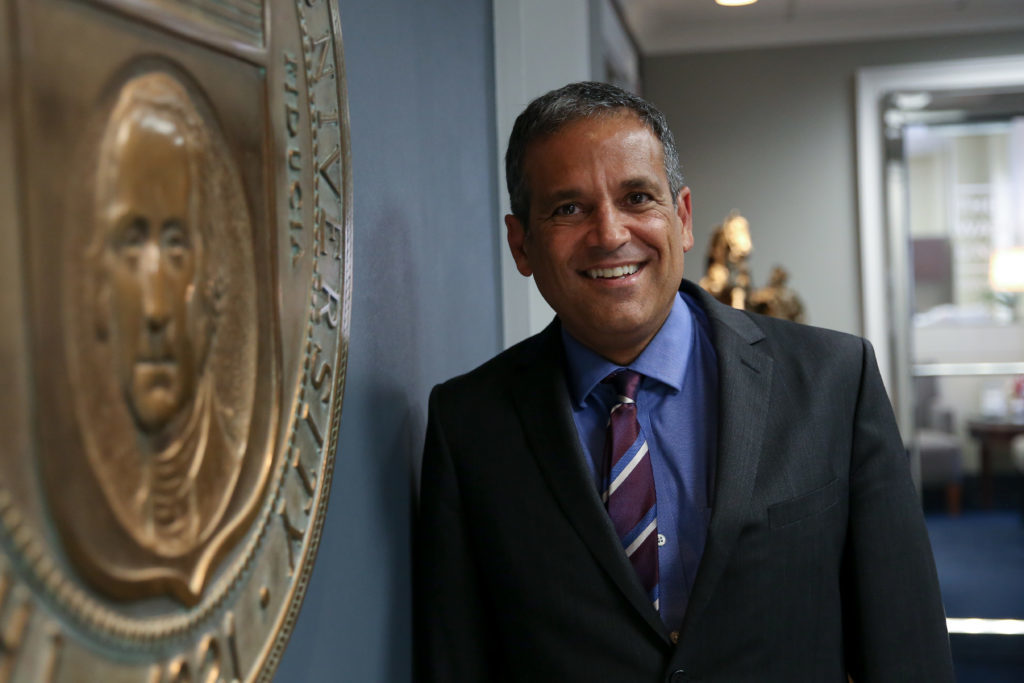Six months after the provost’s office announced GW’s 10 schools would be required to craft diversity plans, no plans have been formally submitted but some schools have implemented new measures to boost diversity.
After a campus climate survey last spring found underrepresented minority groups felt diverse perspectives were often not represented in the classroom, officials asked deans to develop specific plans for increasing racial and socioeconomic diversity through admissions, hiring and retention. Officials said deans haven’t yet created formal plans, but most have implemented new practices – like diversity councils and unconscious bias training – as part of the effort.
Caroline Laguerre-Brown, the vice provost for diversity, equity and community engagement, said the work is still ongoing and that schools would share their progress with each other “in the coming months.”
Last academic year, the School of Business created a diversity council and named its first-ever diversity officer as part of its diversity plan. The law school implemented a “safe zone” faculty and staff training for lesbian, gay, bisexual and transgender identities and launched an implicit bias training for staff in the career center, Laguerre-Brown said.
The nursing school – which has the highest percentage of white students of any GW school – hired an assistant dean for diversity, equity and inclusion last summer and planned a school-wide diversity town hall for later this month.
GW’s largest school, the Columbian College of Arts and Sciences, started unconscious bias training for all new faculty hires after provost’s diversity mandate, Laguerre-Brown said. She said the effort would give schools a chance to collect data and feedback on their diversity policies while setting and monitoring their goals to improve.
“A population of students, faculty and staff with differing perspectives, backgrounds, talents and needs can lead to a richer mix of ideas, energizing and enlightening debates, deeper commitments and a host of educational, civic and work outcomes,” she said in an email. “Leveraging diversity is rarely achieved by accident.”
Laguerre-Brown declined to say whether each dean still planned to submit a formal report or give an exact timetable for when the plans would be submitted.
Provost Forrest Maltzman said schools were focusing on different diversity measures and that the provost’s office was looking to implement unconscious bias training for search committees to avoid members unknowingly favoring different kinds of candidates as the University searches for faculty, students and top officials.
“The schools are working on thinking about hiring and seeing a successful and diverse faculty and recruiting and graduating a diverse student body,” he said in an interview. “It is my expectation that that is occurring across the University and our schools are working on their plans.”
Schools are also looking to change their hiring processes by looking at applicants with broader specializations, which Maltzman said could increase faculty diversity. Despite a major effort to hire minority faculty members in recent years, officials have struggled to increase diversity.
In 2012, about 3 percent of faculty members were Hispanic, 6 percent were black, about 14 percent were Asian and 76 percent of were white University-wide, according to statistics from the Office of Institutional Research and Planning.
Although proposals still have yet to be submitted to the provost, Faculty Senate Executive Chair Sylvia Marotta-Walters said the mandate came at the end of last academic year and deans may have had trouble putting their plans together that quickly.
“I don’t think it’s a commentary on the substance of the proposal. I think that it was presented in early March and then the next month, the semester ends and then summer school,” she said. “So I wouldn’t give up on it coming forward, because I think it probably will.”
Vanessa Perry, a professor of marketing and the leader of the business school’s diversity council, said the school is focusing on retaining students and faculty from diverse backgrounds and to ensure that those students and professors feel comfortable at GW.
The population of white undergraduates in the business school has fallen from 60 percent in 2007 to 46 percent a year ago. Nearly 11 percent of undergraduates in the school were Asian last year, according to institutional statistics.
Lee Teitel, a lecturer on education at Harvard University, said that although the provost’s office has set an overarching goal to increase diversity, schools must take ownership of their own efforts and hold themselves accountable to meet diversity targets on schedule.
“It takes looking at the process you’re trying to fix in a thoughtful way with some folks who take ownership of solving those problems,” he said. “That is more effective in the long run than mandating that something has to be done.”
Teitel said diversity on campus should be more than just demographics. She said individual schools should examine how diverse faculty or students view their experiences at the University and can use that to change systemic issues that may discourage diverse applicants from applying.
The University’s diversity survey last academic year found that just 43 percent of black respondents were satisfied with racial and ethnic diversity on campus, compared to 63 percent of Latino undergraduate students and 73 percent of white respondents. Just 20 percent of black respondents agreed that faculty incorporated diverse perspectives in the classroom.
“It’s not just the numbers of who you get in the door,” Teitel said. “It’s also what the experiences are for people when they get there.”





